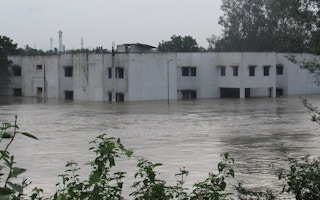“We will have to resurrect an entire city,” was the verdict of one Indian army officer involved in rescue operations after 17 continuous days of record-breaking rainfall devastated the coastal city of Chennai.
Yet the plight of India’s fourth largest city, and other parts of the state of Tamil Nadu, has attracted little attention at the COP21 climate change talks in Paris, which aim to prevent the atmosphere overheating and causing extreme weather events such as the one that has ravaged Chennai.
The scale of the devastation has been vast after rivers and lakes broke their banks when rain three times more than the usual figure fell in the days leading up to the Paris summit.
The confirmed death toll has reached 280, and 28,000 people have had to be rescued. Three million people were left without basic services at the height of the crisis, the cost of which is estimated at more than US$225 million.
Perhaps conference delegates are just getting used to extreme weather. In 2012, it was Haiti and the Philippines that were affected, and a super-cyclone hit the Philippines again in 2013. This year, it is India’s turn.
No monsoon
But India’s prime minister, Narendra Modi, insists: “We are seeing the impact of climate change now. The unseasonal rains resulted in the floods in Tamil Nadu. We have witnessed heavy rains in non-monsoon weather.”
During a radio address to the Indian people before the Paris summit, he stressed the need for capacity-building and spreading awareness about the impact of climate change in India. He also proposed joint exercises by South Asian nations for disaster preparedness.
India’s environment minister, Prakash Javadekar, linked the deluge to the actions of industrialised nations. “What is happening in Chennai is the result of what has happened for 150 years in the developed world,” he said. “Historically, they have reaped the benefits of growth, and now they can’t say that the past is the past.”
More than 50 villages in the region were marooned, and 50,000 people were sent to relief camps that resemble wartime refugee camps.
Two left alive
In the village of Periyakatupalayam, near the coastal town of Cuddalore, the flash floods killed eight members of a single family, including four children.
“We lost everything,” said 50-year-old Amirtham through her tears after she and her son were the only family members to survive. “There is no meaning now for me in living out the evening of my life. I could see my house just washed away with my grandchildren inside.”
Rajalakshmi, a 12-year-old schoolgirl who found a place in the relief camp with her family, said: “I lost my school books in the tsunami in 2004, then in the Thane cyclone in 2011, and again this year. I have nothing with me. There is an empty space and a mass of soil in the place where my house was.”
Gagan Deep Singh Bedi, appointed by the Tamil Nadu government to manage relief work, agrees that the district’s infrastructure must be strengthened in the face of floods and other disasters. “Relief programmes are being carried out,” he says. “We provide food and water, and medical camps are being organised to control water-borne diseases.”

















